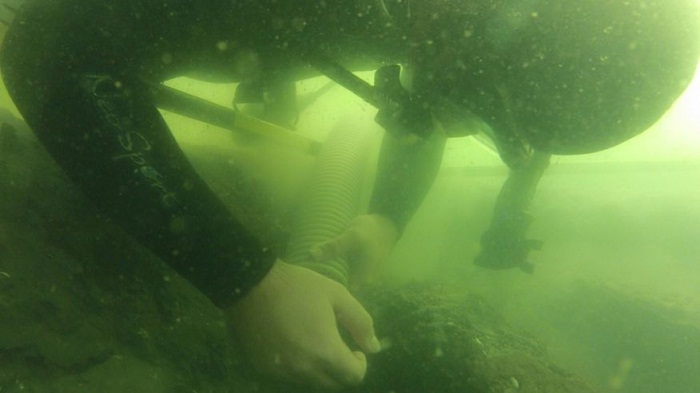Wreck of 16th-century Spanish ship found off Florida coast

"The shipwrecks themselves are giving us insights into these amazing machines they were developing for these voyages that were never really happening before," marine archaeologist Greg Cook, of the University of West Florida, told Live Science. [ Images: See the Lost Luna Shipwreck and Artifacts]
A failed colony
The recently discovered ship was part of a fleet that was led by Don Tristan de Luna, a conquistador who attempted to be the first European to establish a permanent colony in North America. The Spanish fleet launched from Vera Cruz, Mexico, Cook said, with 12 ships carrying a total of 1,500 would-be colonists onboard. It landed in Pensacola Bay on Aug. 15, 1559. On Sept. 19, a hurricane struck . The colonists lost seven ships and many of their supplies, which were being stored onboard.
"It went from being a pretty well-prepared expedition, 24 hours later, to being a survival camp," Cook said.
Some colonists died in the hurricane. The rest tried to push inland, but they lasted only until 1561 before abandoning the settlement. After the disaster, the king of Spain gave up on colonizing the land around the Gulf of Mexico and decided to focus on the East Coast instead, Cook said. St. Augustine, Florida, which was founded four years later in 1565, would go on to achieve the title of the first permanent North American settlement.
The first lost ship in the de Luna fleet, the Emanuel Point I, was found in 1992, and the second, dubbed the Emanuel Point II, was discovered in 2007. In 2015, a local historian noticed pottery shards at a construction site in a residential neighborhood abutting the bay. University of West Florida archaeologists found that the shards were Spanish artifacts dating to the 16th century. The shards were the first terrestrial evidence of the colonists` temporary home, known as the Luna settlement.
New find
As part of a research grant to study the Emanuel Point II wreck and look for more ships, Cook and his colleagues conducted a survey, which was colloquially called "mowing the lawn," between the site of the Luna settlement and the two known shipwrecks. During the survey, marine archaeologists went back and forth in straight lines with a magnetometer, which detects magnetic anomalies from metal on the seafloor. In the summer of 2016, the researchers found roughly 100 magnetic anomalies, Cook said, including one in a sandy-bottomed spot in about 7 feet of water. The Emanuel Point I and Point II shipwrecks are in about 12 feet of water. All of the wrecks are named after a nearby peninsula, since the original ship names aren`t known.
"We thought this would be a good opportunity for students to learn how to do searches," Cook said. The bay is full of metal garbage, he said, from old fishing traps to dumped cars and even discarded pizza ovens, so the team wasn`t expecting a blockbuster find.
"Nine times out of 10, it can be some wire rope from a barge, or a fish trap or crab trap," Cook said.
But within a few minutes of diving, the student archaeologists reported that their probes were hitting rock under the sand. They excavated by hand to find large cobbles — the same sort used as ballast in 16th-century ships. Soon, they turned up ceramic artifacts as well.
Artifacts of life
That wasn`t enough evidence to prove that they had found a shipwreck, though, Cook said. Ships often dumped ballast if they had to take on more cargo, and those piles of rock can mimic the look of a wreck. The team applied to the state of Florida for permission to do a more intensive exploration with dredges.
"It wasn`t until we could dig through and see that we had intact hull timbers that we were willing to say we had a wreck," Cook said. [ Shipwrecks Gallery: Secrets of the Deep ]
The excavation turned up the ship`s frame, outer hull planking and more artifacts, including fragments of olive jars, which were used to carry food, wine and other supplies.
Of the seven ships that were destroyed by the 1559 hurricane, six went down in the bay and one was grounded on shore, Cook said. That means that three more wrecks from the de Luna expedition remain to be found. The artifacts onboard tell archaeologists more about the day-to-day life on these expeditions than leaders like de Luna would ever think to include in their letters, Cook said. For example, on the Emanuel Point II, the team discovered an ivory manicure set deep in a ballast pile, complete with toothpick and ear scoop, he said. The set, which looked a bit like a Swiss army knife, even had a whistle on it that still worked after 450 years, Cook said. It probably belonged to one of the major officers in the fleet, perhaps even to de Luna himself.
"When that was lost, I`m sure it really ruined someone`s day," Cook said.
The team members have covered the initial, excavated portions of the Emanuel Point III with sand to preserve the wood. They`re currently finishing documenting the Emanuel Point II and will likely return to study the third shipwreck in more detail next summer, Cook said. They also plan to keep surveying for more lost de Luna ships.















































